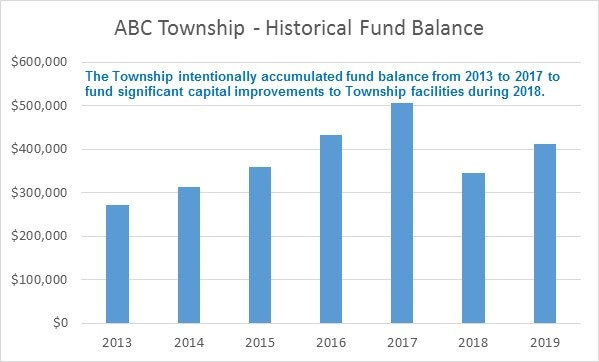In the governmental arena, transparency continues to be a buzzword. The internet is flooded with financial data. Governmental units post budgets on their websites, audited financial reports are publicly available through the Michigan Department of Treasury, and financial information is discussed at board meetings. Yet residents and other stakeholders struggle to interpret what the information means. While governments have strict rules and regulations to abide by when reporting certain information, governments should emphasize producing understandable information. Sometimes less really is more. Here are a few tips to improve how financial information is communicated.
1. Graphs and Pictures
Yes, a picture is worth a 1,000 words! Displaying financial information graphically helps users see the 10,000-foot view. If a user needs a thorough understanding of a particular financial segment, they can review more in-depth reporting.
The City of Midland, Michigan, includes a “City Budget at a Glance” section in its annual budget. This portion of the budget provides basic users with an understanding of the City’s financial outlook in an easily digestible manner.
2. Trends and Context
Presenting current year information in the context of past trends or future forecasts provides users a benchmark of what the information means related to experience or future expectations. If a government wants to demonstrate that measures have been taken to control expenditures, then it would be more effective to present a graph of the level of expenditures over time, than simply presenting the most current actual expenditures or the upcoming budgeted amount. Following is an example.
The dollar amounts involved in governmental finance can be difficult to comprehend, especially when we start talking about millions of dollars. Adding context assists the reader with comprehension. What does it mean when a City plans to spend $10 million on public safety?
Here’s a written example:
Option 1: City of ABC budgeted $10 million for public safety expenditures.
Option 2: City of ABC budgeted $10 million for public safety expenditures which includes police and fire services. The City employs 35 and 25 full time police and fire personnel, respectively. During the prior fiscal year the police and fire departments responded to 12,775 and 2,500 calls, respectively.
3.Outcomes
Discussing financial information as it relates to desired future outcomes or the accomplishment of past goals helps users answer the question, “Why?” Here is a graphical portrayal of a township that strategically increased fund balance in anticipation of significant future capital improvements. This graph answers the following questions:
- Why did the Township’s fund balance increase for several years in a row?
- Why did fund balance decrease in 2018?
- After the 2018 capital improvements was additional fund balance used?

4.Management’s Discussion and Analysis
The Management’s Discussion and Analysis (MD&A) included in the annual financial statements provides management the opportunity to discuss the entity’s financial position and changes in the financial position, in laymen’s terms. Specific situations encountered during the year that had a significant financial impact should be discussed in a way that a basic reader can understand what happened and what the financial impact was. For further information on improving the MD&A, refer to the Yeo & Yeo blog article below.
Management’s Discussion and Analysis – Does Yours Need a Facelift?
When presenting financial information, consider your audience, the level of information required, and the most effective manner of presenting the information. Contact your Yeo & Yeo professional if you need further assistance.

